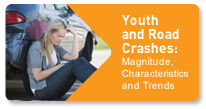About the ProgramMotor vehicle crashes are the leading cause of death and injury for young people (ages 1 through 24)1. Young drivers in general are two to three times (2x-3x) more likely to experience a crash. In particular, during the first six months of licensure, young drivers are eight times (8x) more likely to be involved in a fatal crash than more experienced drivers 2. To address this problem, the Young and New Driver Resource Centre contains research, tools and strategies for young drivers, parents and educators to help reduce the crash risk of young drivers and to improve their safety, and the safety of other road users. Several factors contribute to a teen’s ability to drive safely3. The most basic factors include the skills to operate the vehicle, the ability to recognize hazards and to appropriately react to the unexpected. These skills take time and practice to learn, but are within the reach of young drivers. In addition, they also must learn traffic rules, procedures and the risks and potential consequences of being on the road. This takes time because much knowledge is gained through driving experience. The reality is that young drivers are at a high risk of crashing [1], [2] until they can develop the skills and experience to protect themselves on the road. But, with more experience, drivers can increase familiarity, good judgment and decision-making, and become safe drivers. There are strategies available to deal with the factors that contribute to the high crash risk of teens. The Young and New Driver Resource Centre contains many of these strategies as well as tools that can help teens, parents and educators better understand and navigate the overwhelming process of teaching teenagers how to drive. The Issues section contains research and statistics about road safety issues specific to teens and illustrates why teens are the most at risk age group on the road. For example, teenagers are much less likely to wear their seatbelt4 and more likely to be distracted while driving than older drivers5. If a teen is texting while driving, their chance of crashing is 23 times (23x) higher than if they were not texting6. The Graduated Driver Licencing and Driver Education sections provide an overview of these programs and their requirements in each province and territory, and comparisons across jurisdictions. Learning about Graduated Driver Licencing (GDL) programs and Driver Education (DE) programs can help teens, parents and educators to better understand the important role these programs play in developing safe and confident young and new drivers. The Parent Resources section is where parents can learn the facts and access tools and other materials that can help them to initiate an open, honest and fact-based conversation with their young driver about safety on the road. The Centre also offers a collection of additional resources from other organizations about related road safety programs that can be useful for teens, parents and educators, as well as references to the research literature on young and new drivers for those who are looking for more information. 1 PHAC 2012 References Insurance Institute for Highway Safety (IIHS). (2004). Fatality facts 2004: Older people. Retrieved from: www.iihs.org/research/fatality_facts/olderpeople.html on April 24th 2006. Public Health Agency of Canada (PHAC). (2012). Injury in Review: Spotlight on road and transport safety. Public Health Agency of Canada. Ottawa, Canada. Ranney, T.A. (2008). Driver Distraction: A Review of the Current State of Knowledge. Technical Report DOT HS 810 810 787. National Highway Traffic Safety Administration. U.S. Department of Transportation. Washington D.C Strine, T.W., Beck, L.F., Bolen, J., Okoro, C., Dhingra, S., Balluz, L. (2010). Geographic and sociodemographic variation in self-reported seat-belt use in the United States. Accident Analysis and Prevention. 42(4), 1067-1071. Transportation Research Board (TRB). (2007). Preventing Teen Motor Crashes: Contributions from the Behavioral and Social Sciences. Workshop Report. The National Academies Press. Washington, D.C. Virginia Tech Transportation Institute (VTTI). 2009. New data from Virginia Tech Transportation Institute provides insight into cell phone use and driving distraction. Virginia Tech News. VirginiaTech. Retrieved from: www.vtne ws.vt.edu/a rticles/2009/07/2009-571.html.
|
  |

